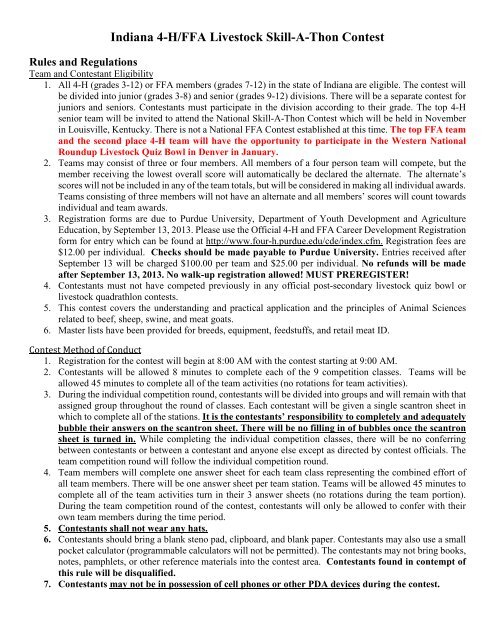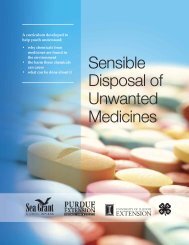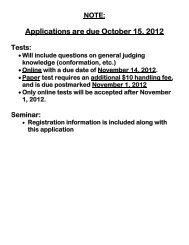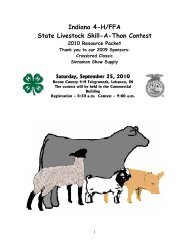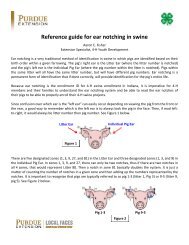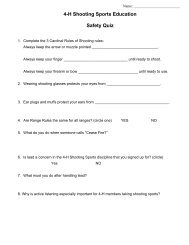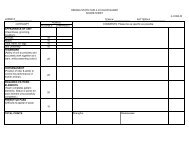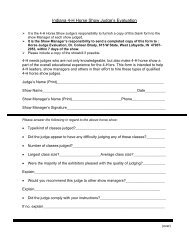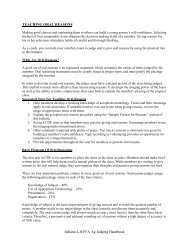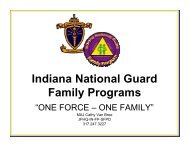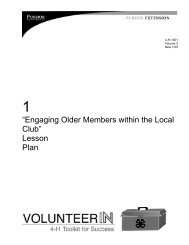Indiana Livestock Skill-A-Thon CDE - Indiana 4-H - Purdue University
Indiana Livestock Skill-A-Thon CDE - Indiana 4-H - Purdue University
Indiana Livestock Skill-A-Thon CDE - Indiana 4-H - Purdue University
You also want an ePaper? Increase the reach of your titles
YUMPU automatically turns print PDFs into web optimized ePapers that Google loves.
<strong>Indiana</strong> 4-H/FFA <strong>Livestock</strong> <strong>Skill</strong>-A-<strong>Thon</strong> Contest<br />
Rules and Regulations<br />
Team and Contestant Eligibility<br />
1. All 4-H (grades 3-12) or FFA members (grades 7-12) in the state of <strong>Indiana</strong> are eligible. The contest will<br />
be divided into junior (grades 3-8) and senior (grades 9-12) divisions. There will be a separate contest for<br />
juniors and seniors. Contestants must participate in the division according to their grade. The top 4-H<br />
senior team will be invited to attend the National <strong>Skill</strong>-A-<strong>Thon</strong> Contest which will be held in November<br />
in Louisville, Kentucky. There is not a National FFA Contest established at this time. The top FFA team<br />
and the second place 4-H team will have the opportunity to participate in the Western National<br />
Roundup <strong>Livestock</strong> Quiz Bowl in Denver in January.<br />
2. Teams may consist of three or four members. All members of a four person team will compete, but the<br />
member receiving the lowest overall score will automatically be declared the alternate. The alternate’s<br />
scores will not be included in any of the team totals, but will be considered in making all individual awards.<br />
Teams consisting of three members will not have an alternate and all members’ scores will count towards<br />
individual and team awards.<br />
3. Registration forms are due to <strong>Purdue</strong> <strong>University</strong>, Department of Youth Development and Agriculture<br />
Education, by September 13, 2013. Please use the Official 4-H and FFA Career Development Registration<br />
form for entry which can be found at http://www.four-h.purdue.edu/cde/index.cfm. Registration fees are<br />
$12.00 per individual. Checks should be made payable to <strong>Purdue</strong> <strong>University</strong>. Entries received after<br />
September 13 will be charged $100.00 per team and $25.00 per individual. No refunds will be made<br />
after September 13, 2013. No walk-up registration allowed! MUST PREREGISTER!<br />
4. Contestants must not have competed previously in any official post-secondary livestock quiz bowl or<br />
livestock quadrathlon contests.<br />
5. This contest covers the understanding and practical application and the principles of Animal Sciences<br />
related to beef, sheep, swine, and meat goats.<br />
6. Master lists have been provided for breeds, equipment, feedstuffs, and retail meat ID.<br />
Contest Method of Conduct<br />
1. Registration for the contest will begin at 8:00 AM with the contest starting at 9:00 AM.<br />
2. Contestants will be allowed 8 minutes to complete each of the 9 competition classes. Teams will be<br />
allowed 45 minutes to complete all of the team activities (no rotations for team activities).<br />
3. During the individual competition round, contestants will be divided into groups and will remain with that<br />
assigned group throughout the round of classes. Each contestant will be given a single scantron sheet in<br />
which to complete all of the stations. It is the contestants’ responsibility to completely and adequately<br />
bubble their answers on the scantron sheet. There will be no filling in of bubbles once the scantron<br />
sheet is turned in. While completing the individual competition classes, there will be no conferring<br />
between contestants or between a contestant and anyone else except as directed by contest officials. The<br />
team competition round will follow the individual competition round.<br />
4. Team members will complete one answer sheet for each team class representing the combined effort of<br />
all team members. There will be one answer sheet per team station. Teams will be allowed 45 minutes to<br />
complete all of the team activities turn in their 3 answer sheets (no rotations during the team portion).<br />
During the team competition round of the contest, contestants will only be allowed to confer with their<br />
own team members during the time period.<br />
5. Contestants shall not wear any hats.<br />
6. Contestants should bring a blank steno pad, clipboard, and blank paper. Contestants may also use a small<br />
pocket calculator (programmable calculators will not be permitted). The contestants may not bring books,<br />
notes, pamphlets, or other reference materials into the contest area. Contestants found in contempt of<br />
this rule will be disqualified.<br />
7. Contestants may not be in possession of cell phones or other PDA devices during the contest.
8. Contestants are not to pick up or touch any item that is being identified or evaluated in the individual<br />
competition classes.<br />
9. Awards will be presented at the conclusion of the contest.<br />
Awards<br />
Junior Awards<br />
Awards for the top three teams<br />
Award for the top individual<br />
Senior 4-H Awards<br />
Awards for the top three teams<br />
Award for the top individual<br />
Senior FFA Awards<br />
Awards for the top three teams<br />
Award for the top individual<br />
Top Junior, Senior 4-H and Senior FFA Individual Overall – Banner<br />
Top Junior, Senior 4-H and Senior FFA Team Overall - Banner<br />
Contest Classes<br />
Individual Classes<br />
1. Retail Meat Cut Identification: (50 points) Identify species (1 pt), wholesale (1 pt), retail (2 pt) and cookery (1pt)<br />
of 10 meat cuts in multiple choice format, spread across two stops (5 retail cuts per stop).<br />
2. Meat Judging: Rank two classes of four similar retail cuts of meat (100 points). Seniors must also answer five<br />
questions on one of the classes (25 points).<br />
3. <strong>Livestock</strong> Feed Identification: (50 points) Identify proper name of 10 feeds (3 pt) and identify each<br />
corresponding nutrient classification (2 pt) in multiple choice format.<br />
4. <strong>Livestock</strong> Breed Identification: (50 points) Identify from pictures, ten breeds (beef cattle, swine, and sheep);<br />
seniors must also match the most appropriate description (Breed: 3 pt, Description: 2 pt).<br />
5. Fleece and Hay Judging Class: (100 points) Rank a class of four hay samples with forage analysis information.<br />
Rank a class of four samples of fleece. A scenario will be provided for both classes.<br />
6. <strong>Livestock</strong> Equipment Identification: (50 points) Identify proper name of 10 pieces of equipment; seniors must<br />
also identify their usage type, i.e. breeding (Equipment: 3 pt; Description: 2 pt).<br />
7. Quality Assurance Exercise: (75 points) Complete a 25-question quiz over how to read a medicine label,<br />
calculate withdrawal times, complete a treatment record, and make responsible management decisions regarding<br />
quality assurance.<br />
8. Quiz: (75 points) Complete a 25-question quiz concerning the total livestock industry.<br />
Total Possible Individual Points = Seniors: 575 Juniors: 550<br />
Team Activities<br />
1. Keep/Cull Exercise (Juniors: 50 points; Seniors: 75 points) Team members will evaluate a group of 8 breeding<br />
animals (beef, sheep, swine or goats) using performance data to make selection/culling decisions based on a given<br />
scenario. Seniors will also answer 5 five-point questions on the class.<br />
2. Judging Class (50 points) Team members will rank a set of 4 breeding or market animals (beef, sheep, swine or<br />
goats). Either could have performance data and/or a scenario.<br />
3. Quality Assurance Exercise (100 points) Complete a 25-question quiz over how to read an animal health product<br />
label, calculate dosage rates and withdrawal times, complete a treatment record, be familiar with administration routes<br />
and make responsible management decisions regarding quality assurance.<br />
Total Possible Team Points = Seniors: 225 Juniors: 200
Total team scores will be determined by adding the three highest individual team members’ class totals with<br />
the total accumulated from the team competition classes.<br />
<strong>Skill</strong>athon Class List<br />
Junior Division<br />
Points Type Class Name Comments<br />
50 Scantron Retail Meat ID 10 items @ 5 points each (Species: 1 pt;<br />
Primal: 1 pt; Retail: 2 pt; Cookery: 1 pt)<br />
50 Scantron <strong>Livestock</strong> Feed ID 10 items @ 5 points each<br />
50 Scantron <strong>Livestock</strong> Breed ID 10 breeds @ 5 points each<br />
100 Scantron Meat Judging 2 classes; Placing Only<br />
50 Scantron Fleece Judging Placing Only<br />
50 Scantron Hay Judging Placing Only<br />
50 Scantron Equipment ID 10 items @ 5 points each<br />
75 Scantron Quality Assurance 25 questions @ 3 points each<br />
75 Scantron Quiz 25 questions @ 3 points each<br />
100 Scantron Team Quality Assurance 25 questions @ 4 points each<br />
50 Raw Team Keep/Cull Selection Only; 50 points<br />
50 Hormel Team Placing Class Placing Only; 50 points<br />
Senior Division<br />
Points Type Class Name Comments<br />
50 Scantron Retail Meat ID 10 items @ 5 points each (Species: 1 pt;<br />
Primal: 1 pt; Retail: 2 pt; Cookery: 1 pt)<br />
50 Scantron <strong>Livestock</strong> Feed ID 10 items @ 5 points each (Feed: 3 pt;<br />
Classification: 2 pt)<br />
50 Scantron <strong>Livestock</strong> Breed ID 10 breeds @ 5 points each (Breed: 3 pt;<br />
Description: 2 pt)<br />
100 Hormel Meat Judging 2 classes; 1 placing only<br />
25 Reasons Meat Judging Questions 5 questions @ 5 points each<br />
50 Hormel Fleece Judging Placing Only<br />
50 Hormel Hay Judging Placing Only<br />
50 Scantron Equipment ID 10 questions @ 5 points each (Equipment: 3 pts;<br />
Use: 2 pts)<br />
75 Scantron Quality Assurance 25 questions @ 3 points each<br />
75 Scantron Quiz 25 questions @ 3 points each<br />
100 Scantron Team Quality Assurance 25 questions @ 4 points each<br />
75 Raw Team Keep/Cull 50 points for selection; 25 points for questions<br />
50 Hormel Team Placing Class Placing Only; 50 points<br />
Master Lists: Breeds, Equipment, Feedstuffs, and Retail Meat ID<br />
Breeds of <strong>Livestock</strong> Master List<br />
Beef<br />
Angus<br />
British breed with highest number of registrations in the US. Noted for mothering<br />
ability and carcass marbling<br />
Brahman<br />
Bos Indicus breed known for heat and insect tolerance.
Brangus<br />
Charolais<br />
Chianina<br />
Gelbvieh<br />
Hereford<br />
Limousin<br />
Maine-Anjou<br />
Red Angus<br />
Red Poll<br />
Salers<br />
Santa Gertrudis<br />
Shorthorn<br />
Simmental<br />
Texas Longhorn<br />
Sheep<br />
Cheviot<br />
Columbia<br />
Corriedale<br />
Dorper<br />
Dorset<br />
Finnsheep<br />
Hampshire<br />
Katahdin<br />
Lincoln<br />
Montadale<br />
Merino<br />
Oxford<br />
Rambouillet<br />
Shropshire<br />
Southdown<br />
Developed in the US, made up of 3/8 Brahman and 5/8 Angus. Bred for heat tolerance<br />
of Brahman and maternal and carcass traits of Angus.<br />
High growth breed originally from France known for muscle and cutability.<br />
Developed in Italy. Known for size and growth, referred to as the tallest breed of cattle.<br />
Developed in Germany, originally considered a dual purpose breed. Has good carcass<br />
cutability and relatively early puberty.<br />
Can be horned or polled. Hardy British breed which in recent years combined polled<br />
and horned associations.<br />
Developed in France with moderate growth rate and frame size and high carcass<br />
cutability.<br />
Developed in France by crossing the Durham and the Mancelle breeds. Has good<br />
muscling.<br />
From Scotland. Considered maternal with good terminal-related performance.<br />
Originally developed as a dual-purpose breed in England that would possess moderate<br />
size, would fatten quickly and also produce a good milk supply.<br />
Found in ancient cave drawings dated 7,000 years ago in France. Considered to be one<br />
of the oldest and most genetically pure of all of the European breeds.<br />
Developed in Texas by crossing the Brahman (3/8) and Shorthorn (5/8) breeds. Became<br />
first official breed developed in the US. Known for heat tolerance and maternal.<br />
Originated in England, with three distinct color patterns, considered a maternal breed.<br />
Originally developed in Switzerland for meat, milk and draft. Now noted for high<br />
growth rate, milking ability, and carcass cutability.<br />
Due to its natural selection and adaption, this breed is considered to be a survival of the<br />
fittest breed. Known for being hardy, aggressive and adaptable.<br />
Small sized meat breed noted for its hardiness from Scotland<br />
Large frame US breed, developed from Lincolns and Rambouillets<br />
Large frame wool breed developed from crossing Lincoln or Leicester rams on Merino<br />
ewes<br />
Primarily a mutton sheep, this breed was developed in South Africa and is one of the<br />
most fertile of sheep breeds.<br />
English, white face, meat breed known for out of season breeding<br />
Lighter muscled breed from Finland noted for being prolific<br />
Large framed, English, meat breed with black face and wool cap<br />
A hair sheep breed developed in the United States.<br />
Although not a popular breed in the US, this breed is unique because the fleece of is<br />
carried in heavy locks that are often twisted into a spiral near the end<br />
Breed developed from Columbia and Cheviot cross noted for high quality carcasses and<br />
excellent wool<br />
Very fine fleece breed with heavy wool production from Spain<br />
This breed originated as the result of crossing Cotswolds and Hampshires and produces<br />
the heaviest fleece of any of the Down breeds.<br />
Wool breed developed in France and Germany from Merino breed<br />
Breed originating in England known as one of the heaviest wool producers among the<br />
medium wool breeds<br />
This breed is early maturing with good lambing ability and average milk<br />
production. They excel in a cross breeding program in their ability to produce meaty<br />
lamb carcasses at light weights and hot-house lambs.
Suffolk<br />
Tunis<br />
Swine<br />
Berkshire<br />
Chester White<br />
Duroc<br />
Hampshire<br />
Hereford<br />
Landrace<br />
Pietrain<br />
Poland China<br />
Spot<br />
Tamworth<br />
Yorkshire<br />
Goat<br />
Angora<br />
Boer<br />
Kiko<br />
Pygmy<br />
Tennessee Woodenleg<br />
Large framed, black faced breed known for high growth rate and carcass cutability from<br />
England<br />
This is a medium sized meat type breed that is also known for their disease resistance<br />
and their ability to remain productive on marginal land.<br />
Originally from England noted for pork quality, tenderness and marbling.<br />
Known as a maternal breed with high conception rates, developed in PA.<br />
Noted for high growth rate, durability and leanness, developed in New Jersey and New<br />
York.<br />
Terminal sire breed with unique color patterns that is noted for muscle and cutability.<br />
Dual purpose breed, red with white markings on head and lower body.<br />
Noted for large litters and large droopy ears, generally refined in bone.<br />
Noted for extreme muscle volume and shape, with a high propensity for stress which is<br />
related to pork quality concerns.<br />
Lean, heavy muscled, black breed with six white points and droopy ears from Ohio.<br />
Black and white, developed in US, noted for rapid growth and as aggressive breeders<br />
Red, rugged, active breed known as a lean type hog with long neck, snout and leg.<br />
Has erect ears, known as the “mother breed”.<br />
The most valuable characteristic of this breed as compared to other goats is the value of<br />
the mohair that is clipped<br />
A prominent strong head with brown eyes and a gentle appearance. Nose with a gentle<br />
curve, wide nostrils, and well-formed mouth with well-opposed jaws. Body should be<br />
boldly three dimensional: long, deep, wide<br />
Known for hardiness and ability to achieve substantial weight gains when under natural<br />
conditions without supplementary feeding. Large framed, generally white with a coat<br />
that ranges from slick in summer to flowing hair when run in mountain country in<br />
winter.<br />
Originally exported from Africa to zoos in Sweden and Germany where they were on<br />
display as exotic animals.<br />
Myotonic, their muscles become extremely stiff when they are frightened. This<br />
hereditary condition makes the goat very muscular.<br />
Source: http://www.ansi.okstate.edu/breeds<br />
Equipment Master List<br />
Tool<br />
Ammonia Diagnostic (animal or<br />
Sensor environment)<br />
Emergency or<br />
Antiseptic preventative health<br />
Applicator treatment<br />
Balling Gun<br />
Beef Cattle<br />
Frame Stick<br />
Emergency or<br />
preventative health<br />
treatment<br />
Fitting and showing<br />
Acceptable Uses<br />
Vaccination/product<br />
administration
Beef Halter Facilities/animal restraint Fitting and showing<br />
Breeding<br />
Catheter Breeding<br />
Cattle<br />
Clippers Fitting and showing<br />
Cattle AI Gun Breeding<br />
Cauterizing<br />
Tail Docker Castration/docking<br />
Curry Comb Fitting and showing<br />
Dehorner Dehorning<br />
Disposable<br />
Syringe<br />
Vaccination/product<br />
administration<br />
Emergency or<br />
preventative health<br />
treatment<br />
Emergency or<br />
Vaccination/product preventative health<br />
Drench Gun administration<br />
treatment<br />
Ear Notchers Identification<br />
Ear Tag Pliers Identification<br />
Elastrator<br />
Electric Fence<br />
Tester<br />
Electronic ID<br />
Tag<br />
Emasculator<br />
Ewe Spoon<br />
Foot Rot<br />
Shears<br />
Forage Probe<br />
Freeze<br />
Branding Iron<br />
Heat<br />
Detection<br />
Patch<br />
Hog Snare<br />
Hoof Chisel<br />
Hoof<br />
Trimmer<br />
Intravenous<br />
Set<br />
Castration/docking<br />
Facilities/animal restraint<br />
Identification<br />
Castration/docking<br />
Obstetrical/neonatal<br />
Emergency or<br />
preventative health<br />
treatment<br />
Diagnostic (animal or<br />
environment)<br />
Identification<br />
Breeding<br />
Facilities/animal restraint<br />
Emergency or<br />
preventative health<br />
treatment<br />
Fitting and showing<br />
Emergency or<br />
preventative health<br />
treatment<br />
Diagnostic (animal or<br />
environment)<br />
Fitting and showing<br />
Emergency or<br />
preventative health<br />
treatment<br />
Vaccination/product<br />
administration<br />
Diagnostic (animal<br />
or environment)
Knife Steel<br />
Lamb Boot<br />
Lamb Tube<br />
Feeder<br />
Nasal<br />
Cannula<br />
Needle Teeth<br />
Clippers<br />
Nipple<br />
Waterer<br />
Nose Lead<br />
Pig<br />
Obstetrical<br />
Forceps<br />
Pig<br />
Resuscitator<br />
Pistol Grip<br />
Syringe<br />
Prolapse Ring<br />
Retainer<br />
Ralgro<br />
Implant Gun<br />
Ram Marking<br />
Harness<br />
Rumen<br />
Magnet<br />
Scalpel<br />
Scotch Comb<br />
Shearer's<br />
Screwdriver<br />
Sheep Shears<br />
Diagnostic (animal or<br />
environment)<br />
Emergency or<br />
preventative health<br />
treatment<br />
Emergency or<br />
preventative health<br />
treatment<br />
Emergency or<br />
preventative health<br />
treatment<br />
Emergency or<br />
preventative health<br />
treatment<br />
Facilities/animal restraint<br />
Facilities/animal restraint<br />
Obstetrical/neonatal<br />
Emergency or<br />
preventative health<br />
treatment<br />
Vaccination/product<br />
administration<br />
Emergency or<br />
preventative health<br />
treatment<br />
Vaccination/product<br />
administration<br />
Breeding<br />
Emergency or<br />
preventative health<br />
treatment<br />
Emergency or<br />
preventative health<br />
treatment<br />
Fitting and showing<br />
Fitting and showing<br />
Fitting and showing<br />
Emergency or<br />
preventative health<br />
treatment<br />
Emergency or<br />
preventative health<br />
treatment<br />
Emergency or<br />
preventative health<br />
treatment<br />
Emergency or<br />
preventative health<br />
treatment<br />
Diagnostic (animal or<br />
environment)<br />
Diagnostic (animal or<br />
environment)<br />
Emergency or<br />
preventative health<br />
treatment<br />
Castration/docking<br />
Vaccination/product<br />
administration<br />
Obstetrical/neonatal<br />
Castration<br />
/docking
Swine<br />
Breeding<br />
Spirette<br />
Tattoo Pliers<br />
Test Tube<br />
Transfer<br />
Needle<br />
Vacutainer<br />
Wool Card<br />
Breeding<br />
Identification<br />
Diagnostic (animal or<br />
environment)<br />
Diagnostic (animal or<br />
environment)<br />
Diagnostic (animal or<br />
environment)<br />
Fitting and showing<br />
Emergency or<br />
preventative health<br />
treatment<br />
Emergency or<br />
preventative health<br />
treatment<br />
Emergency or<br />
preventative health<br />
treatment<br />
Vaccination/product<br />
administration<br />
Vaccination/product<br />
administration<br />
Feedstuffs Master List<br />
Feedstuffs<br />
Whole Shelled Corn<br />
Cracked Corn<br />
Steam Flaked Corn<br />
Corn Gluten Feed Pellets<br />
Corn Gluten Meal<br />
Distiller’s Grain<br />
Whole Soybeans<br />
Soybean Hulls<br />
Soybean Meal<br />
Whole Grain Wheat<br />
Wheat Middlings<br />
Whole Grain Barley<br />
Cottonseed Hulls<br />
Cottonseed Meal<br />
Whole Oats<br />
Rolled Oats<br />
Dried Sugar Beet Pulp<br />
Fish Meal<br />
Feather Meal<br />
Blood Meal<br />
Dehydrated Alfalfa Meal Pellets<br />
Dicalcium Phosphate<br />
Dried Whey<br />
Ground Limestone<br />
Trace Mineral Salt<br />
White Salt<br />
Urea<br />
Dry Molasses<br />
Liquid Molasses<br />
Classifications<br />
Energy<br />
Protein
Mineral<br />
Retail Meat ID Master List<br />
Species Primal Retail Cookery<br />
Beef Chuck Arm Pot-Roast, Bnls Moist<br />
Beef Chuck Blade Roast Moist<br />
Beef Chuck Shoulder Pot Roast (Bnls) Dry/Moist<br />
Beef Chuck Top Blade Steak (Flat Iron) Dry<br />
Beef Flank Flank Steak Dry/Moist<br />
Beef Loin Porterhouse Steak Dry<br />
Beef Loin T-bone Steak Dry<br />
Beef Loin Top Loin Steak Dry<br />
Beef Plate Short Ribs Moist<br />
Beef Rib Rib Roast Dry<br />
Beef Rib Ribeye Steak, Bnls Dry<br />
Beef Round Bottom Round Roast Dry/Moist<br />
Beef Round Eye Round Steak Dry/Moist<br />
Beef Round Tip Roast - Cap Off Dry/Moist<br />
Beef Round Top Round Steak Dry<br />
Pork Ham/Leg Pork Fresh Ham Center Slice Dry/Moist<br />
Pork Ham/Leg Pork Fresh Ham Shank Portion Dry/Moist<br />
Pork Ham/Leg Smoked Ham, Center Slice Dry<br />
Pork Ham/Leg Smoked Ham, Shank Portion Dry<br />
Pork Loin Blade Chops Dry/Moist<br />
Pork Loin Blade Roast Dry/Moist<br />
Pork Loin Center Rib Roast Dry<br />
Pork Loin Country Style Ribs Dry/Moist<br />
Pork Loin Loin Chops Dry<br />
Pork Loin Rib Chops Dry<br />
Pork Shoulder Arm Roast Dry/Moist<br />
Pork Shoulder Blade Boston Roast Dry/Moist<br />
Pork Shoulder Blade Steak Dry/Moist<br />
Pork Side/Belly Sliced Bacon Dry<br />
Pork Spareribs Pork Spareribs Dry/Moist<br />
Lamb Breast Ribs (Denver Style) Dry/Moist<br />
Lamb Leg American Style Roast Dry<br />
Lamb Leg Frenched Style Roast Dry<br />
Lamb Leg Leg Roast, Bnls Dry<br />
Lamb Loin Loin Chops Dry<br />
Lamb Rib Rib Chops Dry<br />
Lamb Rib Rib Chops Frenched Dry<br />
Lamb Rib Rib Roast Dry<br />
Lamb Shoulder Arm Chops Dry/Moist<br />
Lamb Shoulder Blade Chops Dry/Moist<br />
Updated: 9/2014


